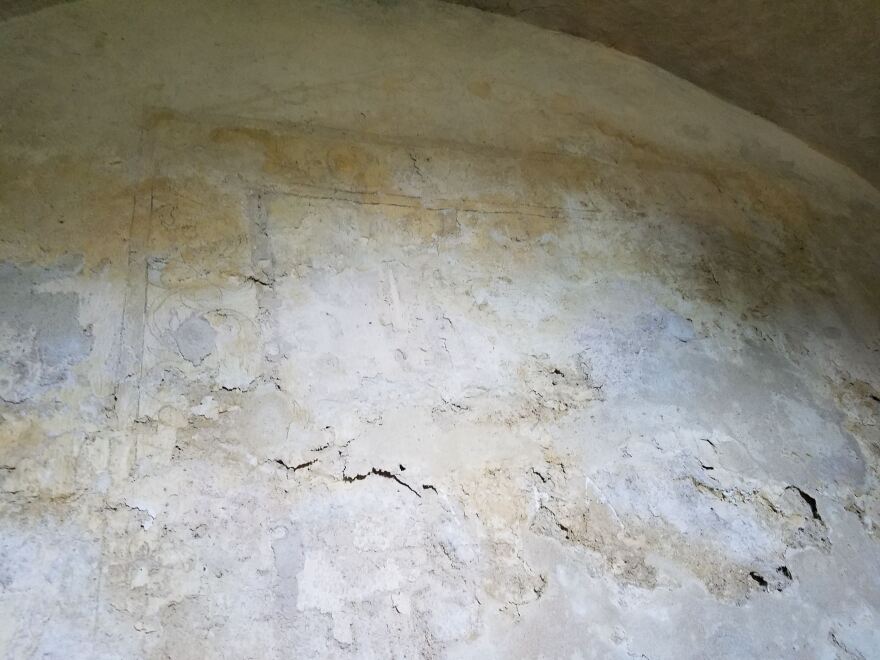A couple of clunky air conditioning units cool San Antonio’s Mission Concepción, but the units’ condensation and decades of humidity and rain have taken a toll on the structure and its art.
San Antonio researchers are investigating how to balance indoor climate management with parishioner comfort and historic preservation. The Mission Concepción was established in 1731. There was no air conditioning back in the day when local Spaniards, Canary Islanders and indigenous peoples came to worship.
Our standards of comfort have changed with time. Condensation from air conditioning units, exterior and interior humidity, and rainfall have led to the gradual degradation of the walls of the church.
Angela Lombardi, associate professor at the University of Texas at San Antonio College of Architecture, Construction & Planning, specializes in historic preservation.
“First of all we have to think we are dealing with a building that has almost 300 years,” Lombardi said. “The building actually is...in pretty good shape. But, of course, there are some problems with drainage, and water and moisture, and rising (dampness). Water, in general, is the big problem for historic buildings. So we realized that the proper management of water including also the condensation (of) water produced by the air conditioning system would have (to be) redesigned, rethought.”
Lombardi and her colleagues spoke near the Mission Concepción's altar, under the church's tall, domed ceilings. The air conditioning unit can be heard humming in the background.

UTSA’s Center for Cultural Sustainability (CCS) is working with local architecture firm Ford, Powell & Carson, and the Archdiocese of San Antonio to conduct a year-long assessment of indoor climate management at the misson's church.
William DuPont, professor in the UTSA Department of Architecture, and director of the CCS, says it’s important to remember it’s not just about the building.
“While it’s a highly technical study, I think it’s important to remember that it’s about people and preservation of living heritage that we’re really engaged in,” DuPont said. “But the real point is to allow the congregation to be worshiping in the church safely, happily, and comfortably so that the church can continue to be a church. The technical work that we’re doing is an effort to support and sustain that living heritage.”
So how does one find that balance between comfort AND preservation?
Antonio Martinez-Molina, assistant professor at UTSA’s College of Architecture, Construction and Planning, leads the project. He specializes in energy efficiency for historic buildings. Martinez-Molina and his students are at the mission every Sunday.

“We are delivering a questionnaire to all the occupants here in the church to try and understand how they felt — if it was too cold, too hot, too humid, the quality of the air — so we could address the problems they raise,” he said.
Martinez-Molina says it’s impossible to gauge what’s “comfortable” for all worshippers.
“People have different standards,” he said. “This...is a multi-angle project because we have to preserve the building, we have to keep the people happy, we have to keep the artwork lasting forever. It’s very difficult to find a sweet spot.”
Mission Concepción was built of porous limestone from a nearby quarry. DuPont says the stone acts like a really stiff sponge.
“If you were to build a building out of a sponge-like material and then set it in the ground, you would expect that sponge would absorb moisture out of the ground,” DuPont said. “And it does. Once that moisture is absorbed, then the principles of science take over and the water has to evaporate out of that sponge. There is an actual evaporation line that you can see in the walls where the moisture is exiting out and the walls above are dryer and the walls below are going through a cycle of wetting and drying. That’s harmful to the painted material that’s on the stone. It’s also harmful to the stone because materials that are moving through the stones and evaporating out are causing some of these issues. When we air-condition the building, we’ve created two different types of climates.”
“The building was not designed to have that forced environment inside the building,” Martinez-Molina added. “We are basically destabilizing the wall moisture.”

That wall moisture has taken a toll on the artwork painted on the mission walls. A 265-year-old fresco in the mission’s baptistry has already been lost to water and to time.
Lombardi, who has researched 2,000-year-old ancient Roman structures, refers to historic buildings as if they are living things.
“Buildings are like people. They age,” she said. “There are exterior causes that can speed up the natural (aging) of a building. When you have old people, you cannot think that the old person does a marathon, but you can think that the old person is able to walk.” She gestured towards the fresco. “Now we have in front of us a person that is (in) a wheelchair.”
The researchers at UTSA hope their research at Mission Concepción will serve as a model for other historic structures in hot, humid climates. They’ll share their findings with the architectural firm Ford, Powell & Carson and the Archdiocese of San Antonio to make recommendations for energy-efficient upgrades that will respect this World Heritage Site and keep it a living piece of history for another three centuries.
Norma Martinez can be reached by email at norma@tpr.org and on Twitter @NormDog1.














